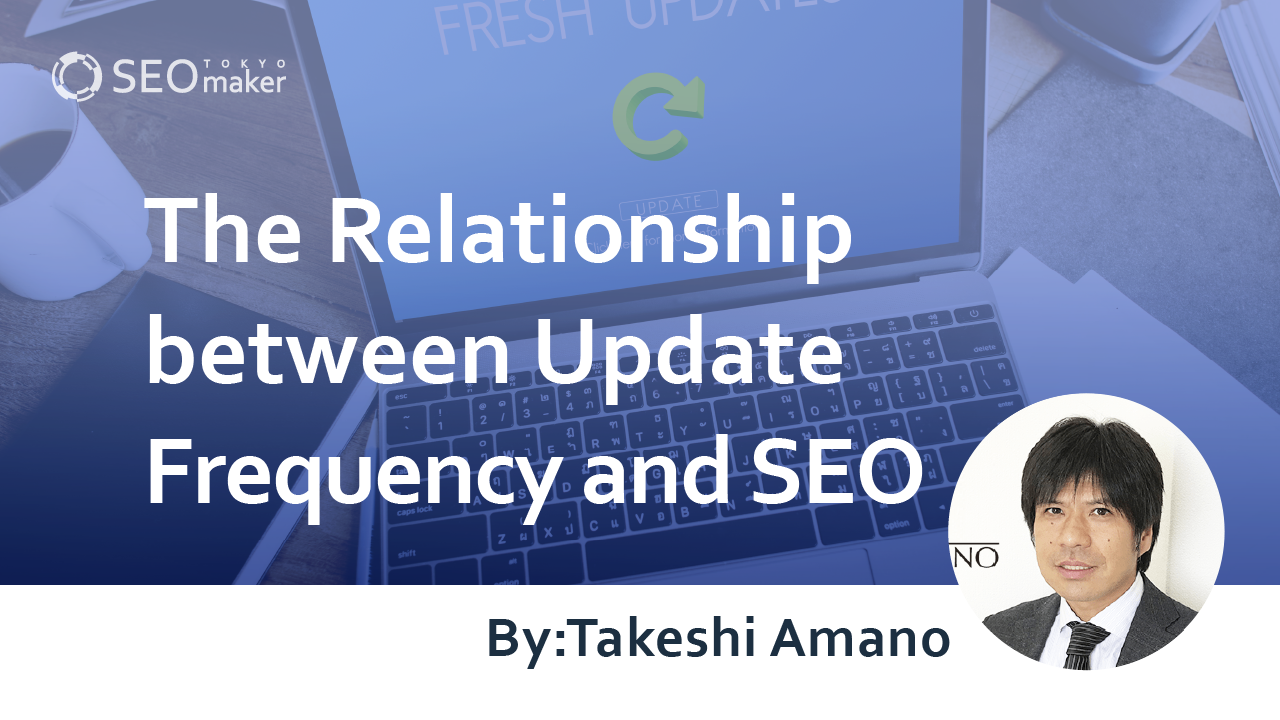The Relationship between Update Frequency and SEO: The Importance of Updates
contents

There is a notion that websites with high update frequencies rank higher in SEO. However, this is not entirely accurate.
Update frequency has no direct correlation with SEO, yet it’s often discussed. While updates may impact search rankings in specific cases, it’s far more important to focus on improving quality.
Tokyo SEO Maker explains the relationship between update frequency and its effects.
The Relationship Between Update Frequency and SEO
First and foremost, let us address the conclusion: there is absolutely no correlation between update frequency and SEO. However, there are countless examples where updating has increased traffic or improved search rankings.
While there may be a correlation between update frequency and SEO, there’s no causal relationship. Similar situations where there’s a correlation without causation exist in various fields.
For instance, a study once showed a strong correlation between blood pressure and income. However, logically, there is no connection between blood pressure and income. The correlation arose because individuals with higher blood pressure tended to be older, and at the time of the study, older individuals typically had higher incomes due to seniority in the workforce.
Although the data is not false, the comparison is incorrect, leading to misunderstandings. The relationship between update frequency and SEO mirrors in this situation.
Updates Do Have an Impact on SEO
While updates themselves do not affect SEO, keeping current information can yield positive results, as explained below.
Some might consider simply changing the publication date of an article or making minor revisions as updates. However, such actions alone will not necessarily improve search rankings.
[Side Story] Genres Where Information Updates Are Vital
Although I just mentioned there is no direct correlation, there are exceptions in all cases. While updated information is generally preferred, in some genres, the speed of information transmission is more critical than anything else.
For instance, in genres like weather forecasts, earthquake alerts, stock prices, foreign exchange rates, train delay information, users often require real-time updates. Information that is a day old, an hour old, or even ten minutes old might be considered outdated. However, targeting such genres as major keywords is not advisable due to their high difficulty level.
There are several ways to assess difficulty, but one essential step is visually confirming if there is a significant amount of informational content when searching. For example, when searching for ‘weather,’ results like ‘what is weather’ typically will not appear. Search engines prioritize results based on user needs.
Conversely, if searches for ‘XX’ return results like ‘what is XX,’ ‘pros and cons of XX,’ or ‘improvement methods for XX,’ it means you can compete in informational queries.
Examples of SEO Effects from Updates
So, what kind of updates can be effective? There are mainly three.
- Adding high-quality content
- Rewriting or removing low-quality content
- Integrating duplicate content
Adding High-Quality Content
Adding new pages is beneficial. It increases indexing and, by addressing new keywords and needs, can boost traffic.
In extreme cases, if site design is sound, adding high-quality articles alone should suffice.
Rewriting or Removing Low-Quality Content
Low-quality content can potentially diminish the overall site evaluation. Therefore, rewriting existing articles is an effective measure. While a few instances of low-quality content might not affect the site’s overall evaluation, the proportion of page quality changes depending on the number of indexed pages. While Google does not assess quality proportions, if there is a noticeably high proportion of low-quality content, users might be dissatisfied, which could ultimately affect search rankings.
Updating outdated or incorrect information from when it was initially published to current information might capture user needs.
If rewriting is not possible, deletion is an option. If neither is feasible, techniques like noindexing or redirecting can be employed.
Integrating Duplicate Content
When operating a site and delivering articles, it’s common to come across similar content. While site design should ideally prevent this, consider integration when similar content arises.
If the content is identical, it’s fine to delete one and redirect, but if there are differences, integration can avoid evaluation dispersion, potentially significantly boosting the evaluation of the remaining articles.
[Side Story] Content that Does not Need to be Kept Updated
It is natural for personnel to contemplate how to respond to each core update. However, core updates typically imply that Google is getting closer to its ideal, and it does not necessarily mean the value of provided content has diminished.
For instance, if an article titled ‘Top 20 Must-Watch Movies of 2020’ previously ranked high, even if its ranking drops at some point, as long as ‘2020’ remains relevant, it could still offer high-quality information.
However, if the majority of users are not interested in “2020,” the “recommended movies” might need to be updated to the latest ones. But should you always update to the latest information? Not necessarily.
For individuals researching history or old information, it could still serve as a reference. In such cases, rather than rewriting, adding new content might be more appropriate.
The Reason Behind the Relationship Between Update Frequency and SEO
In the world of the web, it’s often said that the more you post, the stronger your SEO will be, and some even suggest updating daily. However, this is likely a confusion between correlation and causation.
Having a high update frequency does not directly translate to stronger SEO. Instead, it’s more about reducing low-quality content and overall enhancement. With frequent updates, users are more likely to find the latest information whenever they visit, which can help gather traffic.
Depending on the site’s direction, a higher update frequency may please users, but in some industries or product categories, less frequent updates might suffice.
Examples of the Impact of Stopping Updates
A site stopped updating for about a year. After June 2020, no further updates were made. As a result, traffic declined significantly until November. However, after a core update in December 2020, search rankings improved, and traffic somewhat recovered, even without updates.
Examples Where Stopping Updates Had No Impact
Similarly, another site ceased updates for about a year. Despite no updates after its initial launch, the site maintained stable traffic and earnings. After the December 2020 core update, search rankings improved, leading to increased overall traffic, even without updates.
Differences Between the Two Cases
These examples illustrate the impact of stopping updates and the lack thereof. Both sites dealt with real estate-related content, but the one with declining traffic often published content tied to specific time periods, which lost relevance over time, resulting in decreased user interest.
Content tied to specific time periods often requires immediate publication rather than meticulously crafted articles. While continuous content publication can attract users, ceasing updates can lead to decreased traffic, especially in fields where timing is crucial, like weather or stock updates.
In contrast, the site that maintained or increased traffic without updates focused on delivering high-quality content from the start. By providing timeless information, Google gradually recognized and rewarded the site’s quality, leading to increased traffic over time, even without updates.
[Side Story] Differences from Affiliate Marketing Strategies
While we have discussed general principles so far, affiliate marketing presents a slightly different scenario. In affiliate marketing, some adopt individuals may have a strategy from the outset, but often, it is a case of ‘throwing enough mud at the wall and seeing what sticks.’ Experimentation is key.
Although the goal of capturing user needs and providing content is the same in affiliate marketing, the content posted differs significantly from that provided by companies. This is because the strategies and targets are different.
While there may be differences between the information provided by web media and individual affiliates, both are correct in their own contexts.
Especially since around 2020, there have been frequent core updates that seem to be stringent on affiliate marketing. However, the fundamental direction has not changed since before 2019; it still revolves around how well you satisfy user needs.
Affiliate marketing often requires a stronger push towards advertisements to guide users to conversions. However, pages with excessive ad elements find it challenging to rank higher. To address this, even minor content updates may be necessary.
※ Particularly, companies often employ branding and targeted search techniques. However, in affiliate marketing, the focus is more on converting incoming users rather than revisits or awareness. Therefore, direct comparisons can be challenging.
Summary
Regarding the relationship between site update frequency and SEO, it is not simply about updating frequently to boost SEO rankings. However, sites that update frequently often deliver fresh information to users and receive recognition for well-managed operations. Consequently, they tend to maintain higher SEO rankings. Therefore, rather than viewing site updates solely from an SEO perspective, consider continuous site improvement as a means of serving users better. Instead of aiming solely to boost SEO rankings, let us continue to improve our sites by updating them for the benefit of our users.










![What is a Description? Explaining the Meaning, Writing Style, and Changing Word Count – [2023 Edition]](https://www.switchitmaker2.com/en/wp-content/uploads/2024/09/what-is-description.webp)










